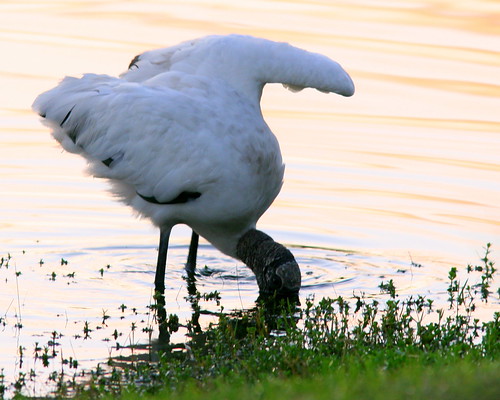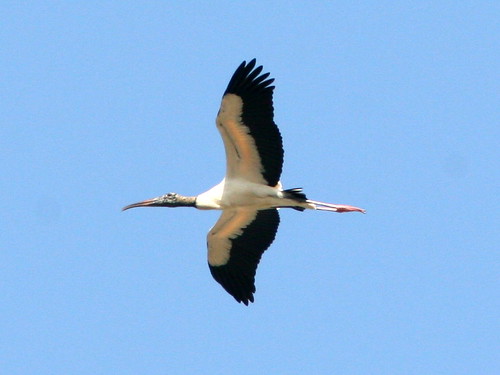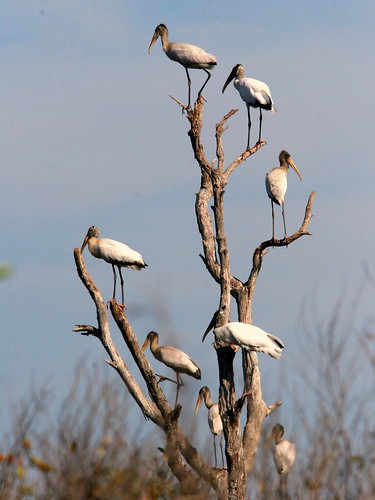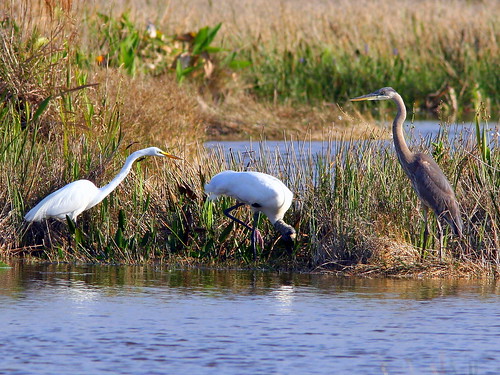Posted by: Ken @ 6:34 am
Wood Stork populations in South Florida have undergone great fluctuations. Breeding success is dependent upon just the right amount of water at the right times. They will not nest at all if there is no water under their rookeries, as the water offers some protection from mammalian predators, particularly raccoons. However, if the water is too deep, alligators will invade the rookery. Once the chicks hatch, it is best if the water depths are receding, as this concentrates the fish. In South Florida, the most optimal foraging months are in mid-winter.
This stork is extending its wing to create a shadow, probably to cause small fish to gather there, as it feeds by touch and not by sight:
Wood Storks are most efficient at catching fish and crayfish that are 1-6 inches in length, generally over one year old. Therefore, successful foraging is restricted to areas that do not dry up entirely before start of the summer rainy season.
This stork, in our back yard, picked up some “salad” with its crayfish:
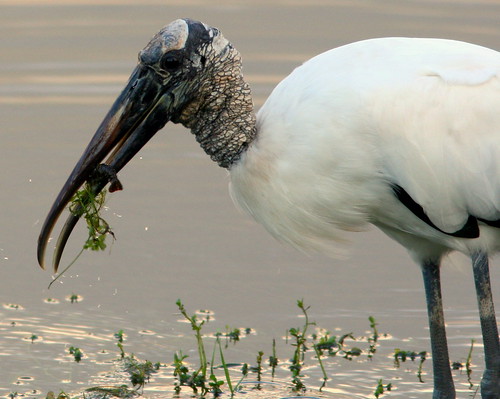
Since they are tactile rather than visual predators, Wood Storks benefit when the water is only 6-10 inches deep and there is a rich “soup” of prey. Young storks require several feedings a day. If water levels are too high or too low, the Wood Storks must fly great distances to find food, and their chicks will starve.
Interestingly, Wood Storks do not fly directly to distant foraging areas. Rather, they must sail on thermals that typically do not develop until mid-morning. This reduces the amount of time that parent birds are able to spend in fishing grounds, increasing the threat to survival of offspring during times when there is too little or too much water.
In January, 2010, a surprisingly large number of immature Wood Storks showed up in our local birding “patch”:
Last year, nesting conditions for Wood Storks were particularly favorable in the Everglades. In censuses taken between 1997 and 2008, the number of successful nests in the Everglades varied widely, between none (in 1998) and a little over 2,000 nests in 2001. More recently there has been a downward trend, with only about 200 active nests in 2008. The number of nests increased dramatically in 2009, to over 4,000.
Immature storks roosted on almost every branch of this dead tree:
Presently, the Wood Stork’s status as an endangered species is being re-evaluated by the US Fish and Wildlife Service. In a preliminary (90-day) finding in response to a petition filed on behalf of the Florida Home Builders
Association. the Agency concluded:
Based on our review, we find that the petition presents substantial scientific or commercial information indicating that reclassifying the U.S. breeding population of the wood stork to threatened may be warranted. Therefore, with the publication of this notice, we are initiating a review of the species’ status to determine if reclassification is warranted.
Irrespective of the agency’s final decision, this species appears to be at risk of localized extinctions, depending on water conditions and continued loss of habitat. (See the updated information below.)
The main purpose of CERP (the Comprehensive Everglades Restoration Program, administered jointly by the US Army Corps of Engineers and the Southwest Florida Water Management District) is to restore sheet flow of clean fresh water to the historic Everglades, at least to the 1/3 to 1/2 of what is left of the “River of Grass.” The Wood Storks would greatly benefit if the original seasonal changes in water lever were reestablished. To do this, many of the ditches and canals that were dug in the middle of the last century to “reclaim” the land for agriculture and development must now be undone.
Aside from the adverse aesthetic and ecological effects, this drainage system also wasted rainwater into the ocean rather than allowing it to recharge our aquifer, which is the source of our drinking water. Decades of excessively low water levels have dried out the peat beds that formerly served as natural “sponges” that helped moderate extremes in flow. Over the years, the peat subsides and compresses, actually forming a barrier that prevents rain water from penetrating, thus increasing runoff and reducing recharge of the aquifer.
Levees are being constructed along the eastern perimeter of the remaining Everglades to control seepage into the ocean and redirect water into its original pathways southward into Everglades National Park. Our own local birding “patch” will eventually be inundated after it is enclosed within a high seepage control levee. We hope that some islands will be constructed within the new reservoir (designated “C-9″ and scheduled for completion in about 10 years), to simulate natural hardwood “hammocks” that dotted the original Everglades. Otherwise we will lose the species that now are harbored in terrestrial habitats.
To control the water flow, CERP is constructing a system of water preservation reservoirs or impoundments. These trap rain water and release it more predictably, actually reducing the threat of flooding in developed land to the east, such as our own neighborhood. The number and size of Stormwater Treatment Areas (STAs) will be increased. These remove excess phosphorus from the water before releasing it to the sheet flow. The phosphorus comes mostly from fertilizer used in agriculture, especially sugar cane cultivation, as well as mining. Healthy Everglades water is normally very poor in nutrients, and the high phosphorus levels allow cattails and exotic plants to replace the Sawgrass. The native plants evolved in the nutrient-poor ecosystem, and are unable to compete with the well-fed invaders.
At the edge of the lawn in our back yard, this Wood Stork stirs the water with its bubble-gum colored feet in hopes of frightening a fish into its waiting open jaws. If they sense a fish, the jaws spring shut. According to the USFWS 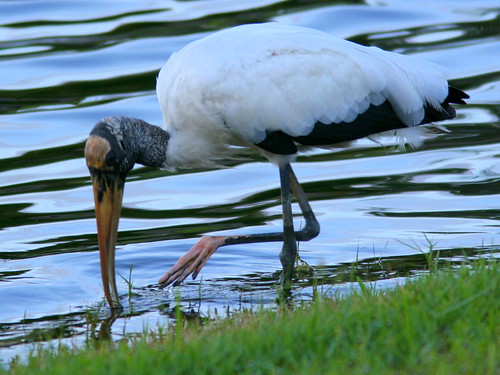
As shown by this photo, the stork typically probes the water with its bill submerged just up to its eyes. It is easy to see why it requires a narrow range of water depths for successful fishing. Its pink feet also look like worms and may attract fish:
In waning light, a Tricolored Heron forages near the stork:
The Tricolored Heron is not endangered, but it also shows wide variance in nesting success in the Everglades, roughly paralleling the Wood Stork trends from year to year.In 2001, nearly 3,500 Tricolored Heron nests were counted, steadily decreasing each year down to about 200 in 2008, and then increasing to 1,200 in 2009.
Several times, I have seen other waders join Wood Storks, perhaps to benefit from fish that are stirred up by the stork. Their differing foraging habits also increase the ability of such a mixed flock to find prey concentrations.
“Fishing Buddies.” A Great Egret, a stork, and a Great Blue Heron congregate in a lake in our birding patch:
Similarly, an egret and a Double-crested Cormorant share a pocket of fish at the edge of our lake:
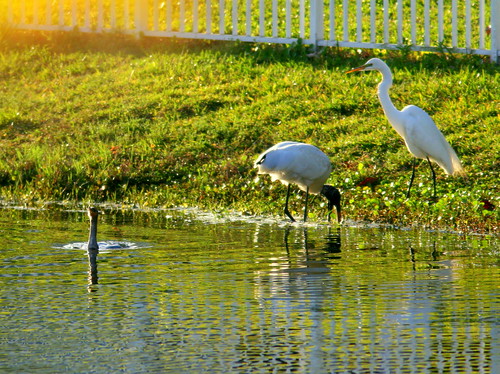
Interactions are not always friendly. Here, a Great Blue Heron chases a Wood Stork up onto a neighbor’s lawn, hoping to steal its booty. It did not succeed:
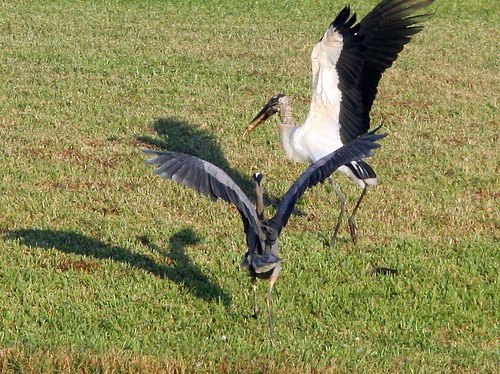
UPDATE (September, 2012)
The Audubon Society provides this evidence-based overview
of the Wood Stork’s precarious status in southern Florida over the last four decades, and the importance of privately-owned wet prairies to their survival.
Although the number of Wood Stork nests outside of South Florida have increased from 1817 in the 1970s to 5491 in the 2000s, the number of nests in South Florida have not recovered, ranging from from 2406 to 2367 over the same period. Nationally the percentage of nests at Corkscrew Swamp declined from 34-37% to only 8% of the US total. There has been total nesting failure at Corkscrew since 2010.
“Audubon has conducted a wood stork foraging study which documented foraging events over the course of two nesting seasons (2006-07 and 2008-09). Data analysis revealed that wet prairies are particularly important to wood storks early in the nesting season. Mapping of foraging locations revealed that 79% of the foraging occurred on private lands in the critical early months of the nesting season. Supporting earlier nesting is critical to recovery efforts for wood stork. This suggests that conservation efforts must involve protecting the foraging values on private lands.”
Florida Home Builders Association v. USFWS
On January 3, 2012, a 60-day notice of intent to sue was sent to USFWS on behalf of Florida Home Builders Association. Attorneys with Pacific Legal Foundation formally warned federal officials that “they will be sued if they do not immediately drop the unjustified listing of the wood stork as ‘endangered’ under the U.S. Endangered Species Act.”
In the meantime, the south Florida rookeries have continued in decline. For the past three years, Wood Storks failed to nest at all in the huge Corkscrew Swamp rookery. To date there has been no final action on the Proposed Rule. For the latest information, visit this
USFWS Wood Stork web page.













